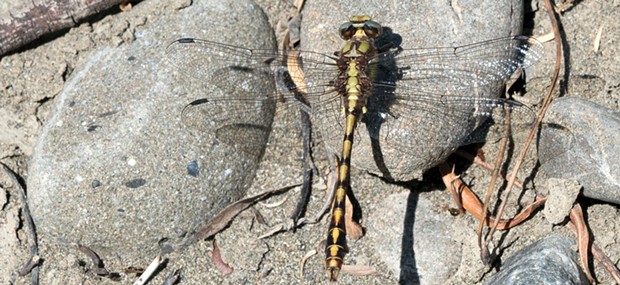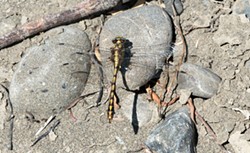Horny Buggers
What you can find in and around the North Coast's ponds, lakes and streams
By Anthony Westkamper[
{
"name": "Top Stories Video Pair",
"insertPoint": "7",
"component": "17087298",
"parentWrapperClass": "fdn-ads-inline-content-block",
"requiredCountToDisplay": "1"
}
]
Three Critters on a River
Anyone who has spent much time poking around streams and rivers has encountered the wondrous "Whirligig Beetle." Shiny black ovals a bit more than a quarter of an inch long, they are a most remarkable animal. Easily seen as they pirouette wildly, skimming along the surface of ponds and slow moving streams. They are rarely, if ever, seen alone but are usually members of a group. As confusing to watch as a game of three card monte, researchers have shown there is a method to the madness. The hungrier an individual is, the farther away from the center of the swarm it is likely to be, as there is less competition than in the center, but less protection from predators. Each of their eyes is divided into two parts: one part to see above the water, the other designed to work submerged. Like race car drivers, one will often follow another closely to reduce drag, a process called "drafting."
I've also seen several species of dragonfly lately, among them the Bison Snaketail (Ophiogomphus bison). This chartreuse, yellow, brown and black dragonfly rests on rocks on the river bar and dashes up to grab prey like those little mayflies out of the air, often returning to its roost to consume the victim. Their name comes from two minuscule "horns" on the head of the female, and the flaring out of the tail near the end, resembling a cobra's hood. The flared abdomen is more pronounced in males.
Water Babies
Like us, the most primitive insects start out as small copies of their adult parents. Their lifestyle will be the same throughout their entire lives as to where they live, what they eat and how they react to stimuli. The silverfish, and bristletails, are of this group.
Next up the evolutionary tree are creatures that start life as small copies of the adults, but lack one distinguishing characteristic: wings. There are a great many insect species that fit this profile, the "true bugs" (order hemiptera) are like this. While each stage resembles the adult in general shape, the last molt into the adult "instar" is when they will get wings and can mate.
They are followed by a most remarkable group, everyone's favorites, the odonata, dragonflies and damselflies. A bit more than 300 million years ago, their larvae returned to the water. Looking at one of their young, it is difficult to tell what it will eventually become. Their shapes are often remarkably different from their adult forms, they breathe water through gills at their rear ends and can expel it forcefully, giving them jet propelled rapid movement. Their jaws snap out on a hinge somewhat similar to the monsters in the Alien movies. Unlike their adult coloration, they are usually well camouflaged; some species going so far as to allow algae to grow on their carapaces. For the most part, they crawl around on the bottoms of ponds, lakes or streams.
Unlike insects even higher on the evolutionary tree, they have no resting pupal or cocoon stage like flies, butterflies and beetles. One day, the larva just pulls itself out of the water, sheds its old exoskeleton, pumps up its wings, dries them and flies away breathing air and capturing prey on the wing. As adults, they can hardly walk at all and will take wing to move an inch if necessary.
It's like a magic trick in slow motion. I've watched the transformation, which can take place in an hour under ideal conditions. Technically, the newly minted adult is called a teneral and, although it can fly, it will be a few days until it takes on its brightest colors and can mate.
more from the author
-
HumBug: Early Spring Pollinators
- Apr 12, 2020
-
HumBug: A Recipe for History
- Apr 5, 2020
-
HumBug: Bugs in the City
- Mar 29, 2020
- More »

































